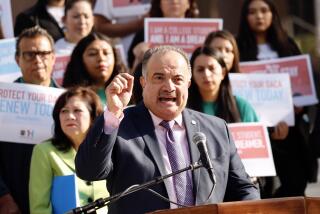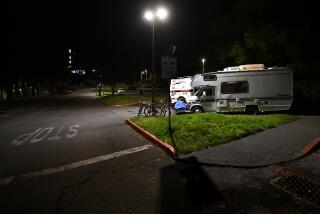Facing Painful Choices at Pierce College
In dreams begin responsibilities. Like many dreamers, I too have a vision of what the future can be for Los Angeles Pierce College. But unlike many dreamers with designs on or for Pierce, I inherited its problematic past and its pristine potential, along with the responsibility of conducting the day-to-day business of a college that was on the verge of losing its accreditation one year before I came in 1996.
Unlike some dreamers, I donât presume to have the authority to convert Pierce into a research and development institution. By law and accreditation, Pierce is a âcomprehensive, two-year community college,â funded strictly as such by the state and governed by the Board of Trustees of the Los Angeles Community College District. Unlike other dreamers, I have to administer multiple collective-bargaining agreements that have much to say about what may or may not be done on campus. And unlike many dreamers, I must abide by Californiaâs âshared governanceâ law.
Effective teaching is what we do best at Pierce, not research. And I am determined to make ours the best community college in Southern California, if not in the state, for transfer readiness as well as for job readiness of students.
Pierce College has taken no position to eliminate any program. This includes agriculture. The important issue for the college, whose accreditation by the Western Assn. of Schools and Colleges (WASC) was recently reaffirmed, is the viability of its academic programs.
Ultimately, students determine whether a program is viable. They vote with their feet. When a program does not fill their needs, they walk away from it.
Fifty years ago, agriculture was the entire Clarence Pierce School of Agriculture, which started with just 101 students--76 day, 25 evening--according to official documents. Today, that school has not one academic program but 50. Instead of 101 students, it has slightly more than 15,000 as of this fall.
What has happened to agriculture as an academic program? Both total college enrollment and ag program enrollment have declined in recent years. But the decline in the ag program, as measured by Full Time Equivalent Students, or FTES, has suffered much more severely.
For purposes of funding by the state, 30 academic credits equal one FTES. For example, if the biology department had 380 people enrolled and each carried six academic credits, the number of FTES would be 380 times six divided by 30, or a total of 76 FTES. (Thus it is possible for a department to have a higher head count and fewer FTES at the same time.) The higher the FTES, the greater the state funding. And so by this measure, the number of heads is not what really counts, but rather how many academic credits each carries during the academic year.
Agriculture department FTES decreased from 252 in fall 1981 to 94 in fall 1996. This is a decline of 62.6% in 16 years. By contrast, the entire collegeâs FTES declined from 7,304 in fall 1981 to 4,204 in fall 1996, a decrease of 42.4%.
Incidentally, the U.S. trend in farming jobs has exhibited a similar decline. The Sept. 15 issue of The Times listed the 10 fastest-shrinking job categories in the United States, with farmer at No. 9. The number of farm jobs is forecast to decline by 227,000 by the year 2005.
In the meantime, Pierceâs 425-acre campus is deteriorating through age and long usage and is very badly in need of repairs. For example, the campus really needs $4 million to finance installation of air conditioning alone, something everyone says should have been done years ago. Also, there are academic programs that could be developed to respond to fast-growing student demand, but which cannot be because of the lack of funds.
The district recently asked Pierce âto live within its means.â The college was tentatively allocated a budget of $25,704,951 for 1997-98, while expenditures for the same period were projected at $29,115,896. The district projects a shortfall of $4.8 million, which needs to be remedied. (The projected shortfall includes Pierceâs share of districtwide indebtedness, anticipated and retroactive collective-bargaining agreement outlays as well as repayment of past Pierce deficits.)
In times of financial distress, painful choices cannot be avoided. Sometimes, cutting one student worker job means that a department can afford to pay for a year of a maintenance contract for not-so-new copiers. At another time, reducing one departmentâs field trip expenditures may mean another department can offer an additional in-demand course.
*
Before I assumed the presidency, the collegeâs accreditation became âat riskâ when the WASC deferred it for two reasons: financial instability and significantly high administrative turnover. In institutions of higher education, accreditation is tantamount to license to operate. Without it, the college shuts down.
At the end of my first year at Pierce, our team of faculty, staff and administrators secured reaffirmation of our accreditation. We succeeded because we showed the WASC that we have stopped the administrative turnover and are working very hard to create financial stability, not only through cost cutting but also by being creative and willing to consider all kinds of ideas that would generate revenue and make the college less dependent on funds from the district and state.
It is in connection with the search for revenue enhancement options that the Pierce College Council reopened discussion (broached in 1993) of placing a golf driving range on campus. A few people have decided not to participate in the council discussions. This is, of course, within their rights. But it is disappointing that they have not only deprived the council of their ideas but also have criticized it for going through a process mandated by Californiaâs shared governance law. Under this law, all major issues that impact on the academic, fiscal and institutional health of the college are openly deliberated by the campuswide council. The president has no vote in it.
A majority vote of the council resulted in a request for proposals, an effort to gather data and business plans from contractors that can shed light on the desirability (or lack of it) of a driving range. When the proposals come in, the council will analyze and discuss them and make a recommendation to me. I will then carefully evaluate this recommendation and decide to reject or accept it. Externally, there is of course an environmental impact hearing that will occur.
Because we want to retain our accreditation, Pierce College will continue to search for ways to generate revenue, not only to supplement its modest funds for badly needed repairs but also to create seed money to finance new programs in great demand by students.
A glorious past is no assurance of a sound future. If we do not solve our financial problems in the short run, Pierce College will have no long run to speak of. This applies to all programs of the college.






